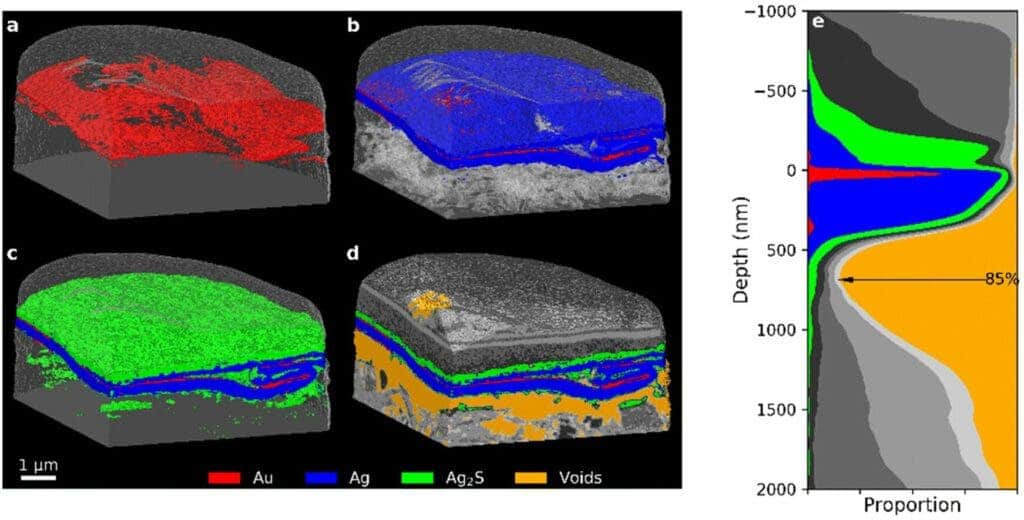Restoring middle age sculptures has proven to be remarkably difficult, and now researchers may have figured out why: the secret is nanoscience.

A nanomaterial from the Middle Ages
Throughout history, gold has been a favored material for displaying wealth and power. In the medieval hierarchy, gold reflected the splendor of God and was the favorite material of kings and rulers. But gold also played an important role in art. The technical innovation of gilding (thin leaves of gold used to cover a surface) significantly reduced the cost of producing large “golden” artworks and also expanded the decorative use of gold.
Middle Ages artists often used a wafer-thin film of gold supported by a layer of silver to gild sculptures. A further innovation appeared in medieval Europe as gold was backed by a thicker and cheaper metal (usually silver) so that the expensive gold layer could be made thinner than gold and reduce gilding costs. This new laminated metal has been known by many names but it’s commonly referred to by the German word Zwischgold (literally meaning ‘part gold’).
Zwischgold, essentially a bi-layered metal foil from gold and silver, started appearing in artworks started in paintings from the early 13th century and became popular in German sculptures from the 14th century. Since it has a real gold surface but requires much less gold than normal gold leaf, it’s typically argued in previous studies that it was used back then as an economic alternative to gold leaf.
“Although Zwischgold was frequently used in the Middle Ages, very little was known about this material up to now,” Benjamin Watts, a researcher at the Paul Scherrer Institute in Switzerland and a study co-author, said in a statement. “So, we wanted to investigate the samples using 3D technology which can visualize extremely fine details.”
But there’s more to Zwischgold than meets the eye.

Looking into Zwischgold
The samples chosen for the study, examined at the Swiss Light Source using modern microscopy techniques, were unusual for the researchers: small bits of material from wooden statues and a 15h-century altar. The altar was likely made in 1420 in Germany and for many years stood in a mountain chapel. Now it’s exhibited in the State Museum in Zurich.
While other microscopy techniques were previously used to examine Zwischgold, they only provided a 2D cross-section through the material – meaning only the surface of the cut segment was visible instead of the inside. The advanced microscopy method used now, called ptychographic tomography, provided a 3D image of Zwischgold’s exact composition.
Ptychography is a sophisticated method, as there’s no objective lens that forms an image directly on the detector, Watts said. Instead, ptychography creates a diffraction pattern of the illuminated area, such as an image with points of varying intensity, using computation methods to recover the image. If you move the sample in a well-defined way, you can create hundreds of overlapping diffraction images.
There are no records of how Zwischgold was produced at the time. However, based on the nanoscale images and documents from later epochs, the researchers now know the method used in the 15th century. The gold and silver were first hammered separately to produce thin foil and then the two metal foils were worked together, they explained.
“Our investigations of Zwischgold samples showed the average thickness of the gold layer to be around 30 nanometers, while gold leaf produced in the same period and region was approximately 140 nanometers thick,” Qing Wu, the study’s first author, said in a statement. “This method saved on gold, which was much more expensive.”
So it turns out that this complex material, which may have been used because it was cheaper, actually has more going for it than initially thought. But there’s also a downside: the silver can push through the gold and cover it relatively quickly, even at room temperature. The silver can then become oxidized and ruin the beautiful appeal of the material. The artisans were aware of this problem and took measures to address it, but these measures hid the secrets of Zwischgold.
“This makes the gold surface of the Zwischgold turn black over time,” Watts explains. “The only thing you can do about this is to seal the surface with a varnish so the sulfur does not attack the silver and form silver sulfide.” The artisans using Zwischgold were aware of this problem from the start. They used resin, glue or other organic substances as a varnish. “But over hundreds of years this protective layer has decomposed, allowing corrosion to continue,” Wu explains.
Now, researchers are looking at ways to restore the material and its coating without damaging the structure.
The study was published in the journal Nanoscale.









